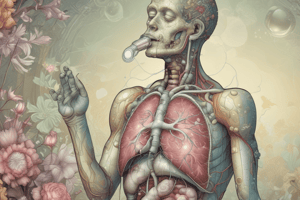Podcast
Questions and Answers
What is the primary mechanism of action of inhaled corticosteroids in treating asthma?
What is the primary mechanism of action of inhaled corticosteroids in treating asthma?
- Reduce inflammation and swelling in airways (correct)
- Relax airway smooth muscle
- Prevent mast cell degranulation
- Inhibit production of leukotrienes
Which medication type is indicated for mild to moderate asthma and exercise-induced bronchospasm?
Which medication type is indicated for mild to moderate asthma and exercise-induced bronchospasm?
- Leukotriene modifiers (correct)
- Beta2-agonists
- Mast cell stabilizers
- Inhaled corticosteroids
What is the focus of pharmacogenetics in the context of asthma treatment?
What is the focus of pharmacogenetics in the context of asthma treatment?
- Developing new medications for asthma
- Understanding genetic variation affecting response to medications (correct)
- Studying the side effects of medications
- Analyzing the causes of asthma
What is the primary purpose of bronchodilators in asthma treatment?
What is the primary purpose of bronchodilators in asthma treatment?
Which medication type is used to prevent mast cell degranulation, reducing bronchospasm and inflammation?
Which medication type is used to prevent mast cell degranulation, reducing bronchospasm and inflammation?
What is a potential side effect of inhaled corticosteroids, particularly at high doses?
What is a potential side effect of inhaled corticosteroids, particularly at high doses?
Flashcards are hidden until you start studying
Study Notes
Inhaled Corticosteroids
- Most effective long-term control medication for asthma
- Reduce inflammation and swelling in airways
- Examples:
- Fluticasone (Flovent)
- Budesonide (Pulmicort)
- Triamcinolone (Azmacort)
- Dose-dependent side effects:
- Oropharyngeal candidiasis
- Dysphonia
- Adrenal suppression (high doses)
Leukotriene Modifiers
- Inhibit production of leukotrienes, which cause airway constriction and inflammation
- Examples:
- Montelukast (Singulair)
- Zafirlukast (Accolate)
- Indications:
- Mild to moderate asthma
- Exercise-induced bronchospasm
- Side effects:
- Headache
- Gastrointestinal disturbances
- Churg-Strauss syndrome (rare)
Pharmacogenetics
- Study of genetic variation affecting response to asthma medications
- Genetic polymorphisms influencing response to:
- Beta2-agonists
- Corticosteroids
- Leukotriene modifiers
- Implications:
- Personalized medicine
- Tailored treatment approaches
- Improved treatment outcomes
Bronchodilators
- Quick-relief medications for acute asthma symptoms
- Types:
- Beta2-agonists:
- Short-acting (SABA): Albuterol (Ventolin)
- Long-acting (LABA): Salmeterol (Serevent)
- Anticholinergics:
- Ipratropium (Atrovent)
- Beta2-agonists:
- Mechanism:
- Relax airway smooth muscle
- Increase airflow
- Side effects:
- Tremors
- Anxiety
- Tachycardia
Mast Cell Stabilizers
- Prevent mast cell degranulation, reducing bronchospasm and inflammation
- Examples:
- Cromolyn sodium (Intal)
- Nedocromil (Tilade)
- Indications:
- Mild to moderate asthma
- Exercise-induced bronchospasm
- Side effects:
- Cough
- Bad taste
- Gastrointestinal disturbances
Studying That Suits You
Use AI to generate personalized quizzes and flashcards to suit your learning preferences.




